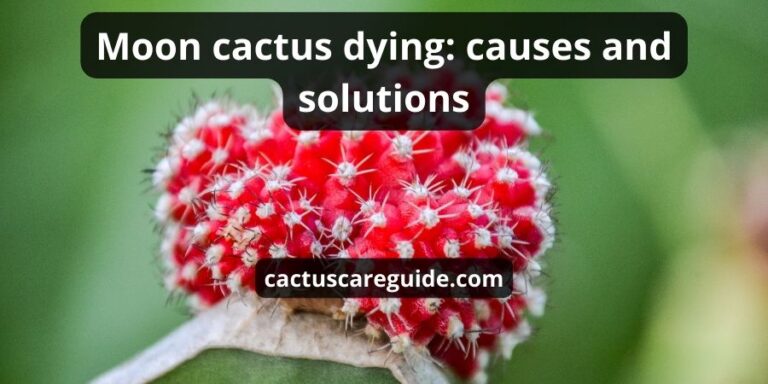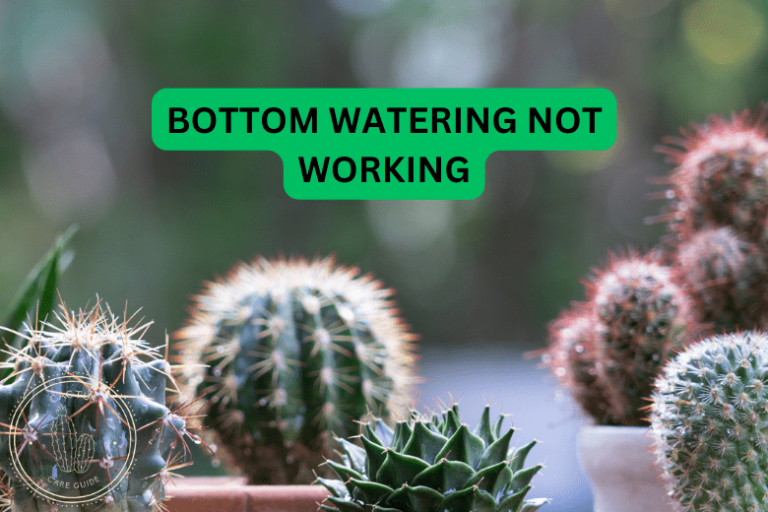How to treat black spot on cactus plants: an easy guide
Black spots on cacti can be a gardener’s nightmare, but fear not!
From saguaro cacti to prickly pears, this comprehensive guide is designed to help you identify and treat black spots on various cactus species.
It will walk you through the causes and treatments to help your prickly friends thrive again.
Understanding the basics
Before diving into the nitty-gritty of treating black spots on your cactus plants, it’s essential to understand some basics.

Knowing the common types of cacti and recognizing the signs of a fungal infection can go a long way in effective treatment.
Common types of cacti species
Understanding the types of cacti species is crucial for effective treatment.
From the saguaro cactus to prickly pear cacti, each plant species has its own set of needs and vulnerabilities.
The saguaro cactus is celebrated for its majestic height and impressive water storage capabilities; however, it faces susceptibility to fungal infestations and potential physical harm.
Prickly pear cactus is adaptable to various sizes and shapes, and requires minimal watering, but can be susceptible to environmental stress, pests, and diseases.
So knowing your cactus type can help you tailor your treatment approach.
Signs of a fungal infection
Fungal infections can quietly affect cactus plants. Look for dark or brown spots on the plant’s tissue, indicating a potential bacterial infection.
Vigilance is your greatest asset. Regular inspections are paramount for indoor cacti, allowing you to address issues swiftly and prevent them from escalating.
Cacti nurtured indoors are particularly vulnerable due to the controlled environment, which can inadvertently create conditions favorable for fungal growth.
Early detection is key, so make sure to regularly inspect your cacti, especially if they are indoor plants.
Also Helpful: How Do You Get Rid of White Fungus On Cactus
Identifying the causes
Now that you’re familiar with the basics, it’s time to know what’s causing those unsightly black and brown spots anywhere on your cactus.
No matter if you have a saguaro cactus or a prickly pear cactus, it’s essential to identify the specific cause of the black spots on the cactus to determine the appropriate treatment or preventive measures.
In some cases, black spots on cactus may be superficial and not a significant concern, while in others, they may be indicative of a more severe underlying issue that requires attention and care.
From sun damage to pest infestations, various factors can lead to this issue.
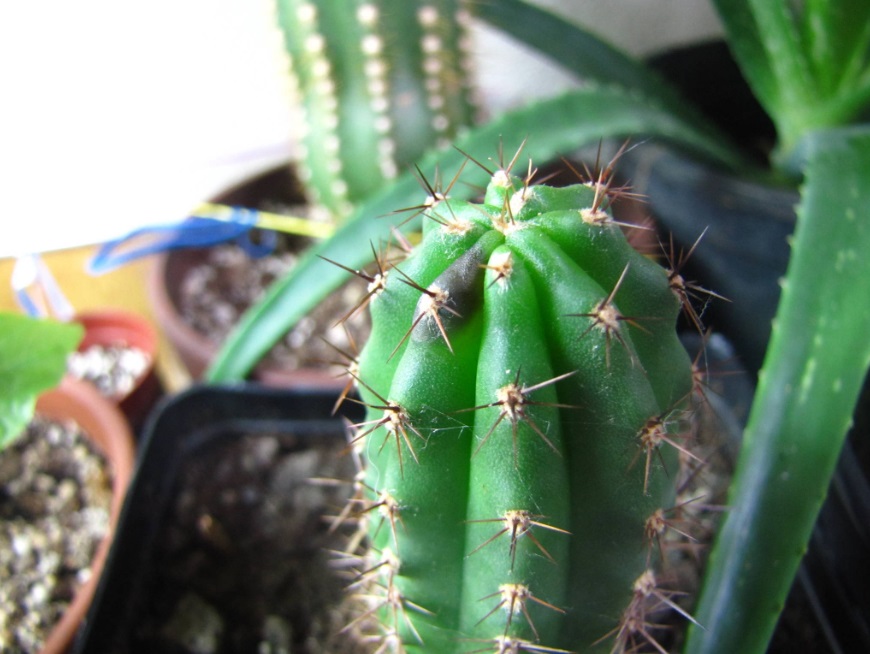
Sun damage
Excessive sun exposure can cause black spots on cactus plants. Direct sunlight can be harmful, especially for indoor plants.
If you notice that the black spots on the cactus are primarily on the side facing the sun, it’s a clear indicator that your cactus is getting too much sunlight.
Treating sun-damaged black spots on cactus plants
Move your cactus to a location with indirect light. Too much sun can cause chemicals to burn the skin tissue of the cactus.
Consider using curtains or shades to filter the direct sunlight, and monitor your cactus for any improvements.
Excess water
Cacti plants don’t need too much moisture. Excess water can lead to root rot and other fungal diseases.
Overwatering is a common mistake, especially for those new to cactus care. Make sure you’re not making this error.
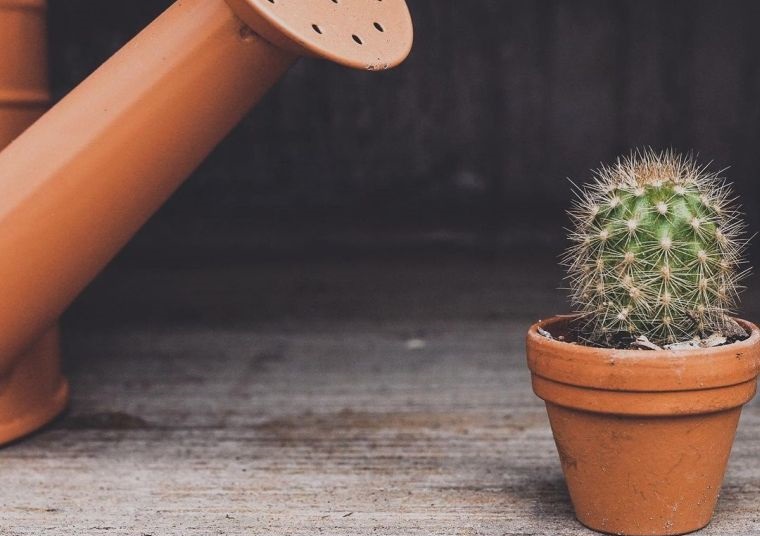
Skip watering for days or even weeks
Use a moisture meter to check the soil line. If it’s wet, skip watering. This will prevent cactus root rot too.
Remember, cacti are desert succulents and are used in conditions where water is scarce.
Frost damage
Cold temperatures can affect cacti, leading to black spots. Even desert succulents like the barrel cactus are susceptible.
Frost damage is especially common in cacti kept outside during the winter months.
Do freezing temperatures affect cactus color?
Yes, frost damage can turn a healthy green cactus into a blackened cactus.
Keep your cacti away from cold drafts, and consider bringing outdoor cacti inside during the winter.
Pest damage
Spider mites and other pests can cause dark spots on your cactus leaves.
Pests usually attack plants that are already weakened, so a pest infestation can be a sign of other issues as well.
Recommended: How to get rid of cactus bugs

Remove the pests manually once spotted
Use insecticidal soap or even a gardening knife to remove pests.
Make sure to isolate the affected cactus from other plants to prevent the spread of the infestation.
Regularly inspect your cactus and the surrounding area to ensure that all pests have been removed.
Chemical damage
Too much fertilizer or inadequate air circulation can lead to chemical burns. The chemicals burn through a plant’s skin tissue causing black spot lesions.
Chemical damage is often overlooked but can be as harmful as any disease.
Treating chemical-induced black spots on cactus plants
Flush the potting mix with water and move the cactus plant to an area with better air circulation.
If you’ve recently fertilized your cactus plant, consider flushing the soil to remove any excess fertilizer.
Leaf spot damage
Common fungal diseases like Phyllosticta pad spotting can cause leaf spot damage.
This is often a result of high humidity or poor air circulation around the plant.
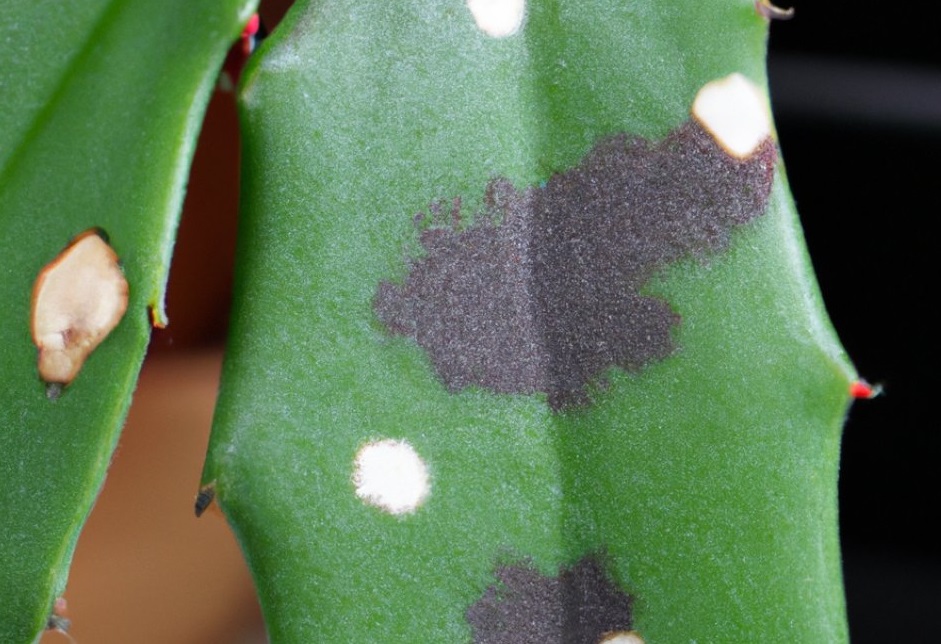
Treating leaf spot damage on cactus plants
Cut away the affected areas using pruning shears and treat the whole plant with fungicides.
Make sure to sterilize your shears before and after to prevent the spread of the disease.
Initial steps for treatment
Once you’ve identified the cause, the next step is to start treatment.
These initial steps are crucial for the successful recovery of your cactus plant.
Isolate your plant
The foremost action in your cactus’s road to recovery involves isolation. By isolating the affected cactus, you erect a protective barrier against the potential spread of fungal or bacterial disease.
This means relocating your infected plant to a separate room, distinctly apart from your other cherished green companions, including vegetable plants and indoor plants.
Remove any damaged parts
Use a surgical approach by wielding a gardening knife with precision.
Your goal is to excise any dark brown or black spots that have marred your cactus’s otherwise vibrant appearance.
The key is to cut deep into the healthy tissue, ensuring that no vestiges of the affliction remain.
To prevent any inadvertent contamination, diligently sterilize the knife both before and after use, minimizing the risk of bacterial or fungal infection spread.
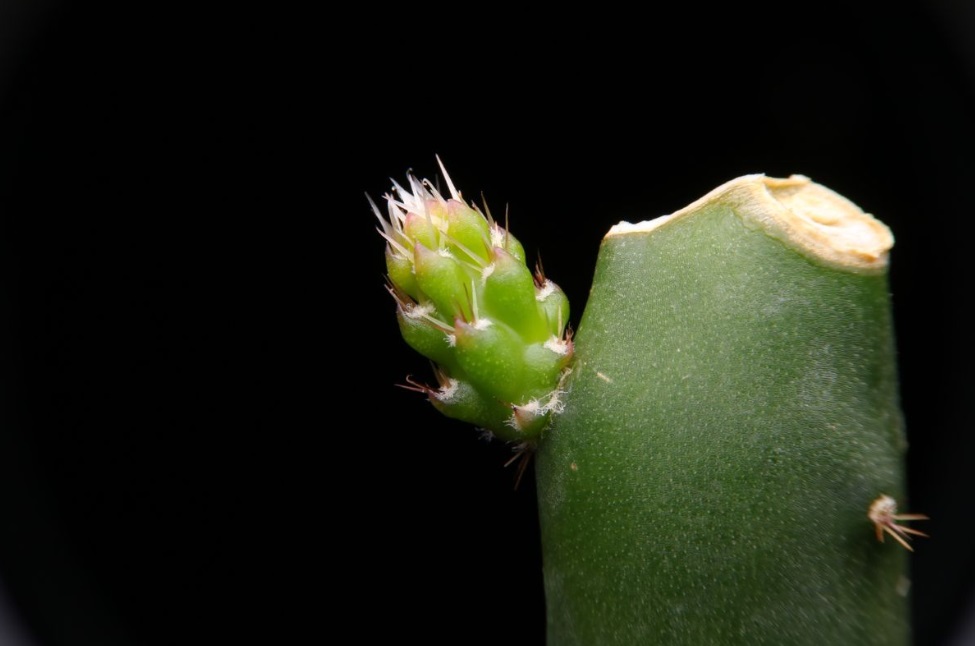
Transfer your cactus to a new location
Consider a change of scenery as a therapeutic intervention. Sometimes, moving your cactus to a new environment can bolster its resilience against fungal diseases.
Whether you opt for an indoor garden or another room with different conditions, the objective is to provide an atmosphere where your cactus can recover optimally.
Place your cactus in areas where heat is radiated
Heat can be a formidable ally in the battle against fungal and bacterial diseases. It possesses the capacity to eliminate these intruders.
However, a word of caution: ensure that your cactus is not placed in proximity to heat sources like radiators, as this can cause other problems like drying out.
Use indirect lighting and cooler temperatures in the room
Embrace indirect lighting and maintain cooler temperatures within the designated room.
These factors can play a pivotal role in your cactus’s journey to recovery, particularly if it is a species sensitive to environmental changes.
Indirect light and cooler temperatures create a conducive environment for healing, especially when dealing with conditions like bacterial necrosis.
Treating specific conditions
Once you’ve initiated the initial treatment steps, it’s important to address specific conditions affecting your cactus.
Whether dealing with fungal or bacterial issues, a tailored approach is often necessary to ensure the health and vitality of your beloved plants.
How to treat fungal diseases on cactus plants?
Fungal diseases are a common concern for cacti enthusiasts. To tackle these fungal adversaries effectively, consider the following steps:
- Fungicides as a shield. Use fungicides to fend off fungal infections. Additionally, contemplate repotting your cactus in fresh potting soil, ensuring a clean start for your plant’s recovery journey. Always adhere to the instructions provided on the fungicide packaging for optimal results.
- Prevention through treatment. Adopt the adage that “prevention is better than cure.” Extend your treatment to healthy, adult plants to safeguard against future outbreaks. This becomes especially crucial if you’ve previously had to remove a severely infected plant.
- The tough choice. Sometimes, the most prudent decision is to part ways with a severely infected cactus plant. It’s a difficult decision to make, but it’s often necessary to prevent the spread of disease from infected plants.
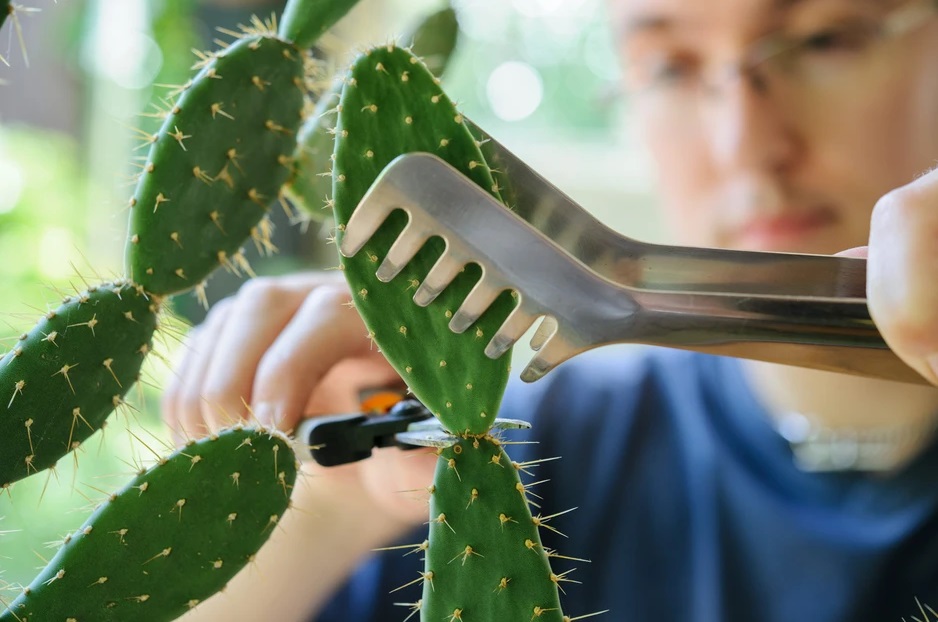
How to treat bacterial diseases on cactus plants
Bacterial diseases can prove equally devastating to your cactus plants. Here’s how to handle them:
- Effective antibiotic intervention. In the case of bacterial infections like bacterial necrosis, antibiotics can be a potent solution. However, it’s crucial to use them as a last resort and only under the guidance of a horticultural professional.
- The menace of bacterial necrosis. Bacterial necrosis is a severe infection that can penetrate the plant tissue and rapidly infiltrate the whole plant. To combat it, surgically excise the affected areas and initiate treatment with antibiotics or other recommended remedies.
Managing Phyllosticta pad spotting
Phyllosticta pad spot is yet another bacterial disease that can affect your cacti. Combat it with the following steps:
- Targeted removal. Begin by carefully removing the affected cactus pads. This surgical approach helps halt the disease’s progress.
- Fungicidal defense. Apply a suitable fungicide to the affected areas, strictly adhering to the application guidelines specified on the product’s packaging.
Treating crown rot and root rot
Crown rot disease and root rot are common issues that can affect a cactus.
These conditions are often the result of overwatering or poor drainage.
If you suspect crown rot in your plant, it’s crucial to take immediate action to prevent it from spreading to other nearby plants.
Enhance the drainage of your potting mix and consider using a fungicide to address the impacted areas.
Applying a layer of gravel or rocks to the soil surface can enhance moisture control and, consequently, prevent cactus rot.
Also Check Out: How Do You Know If a Cactus is Dead
Ongoing care
Treating your cactus for black spots is not a one-time affair.
Ongoing care is essential to ensure that the problem doesn’t recur.
Caring for your blackened cactus does not end here
Regular checks for black spots and proper care can keep your cactus alive and well.
Make sure to adjust your watering schedule and keep an eye on the lighting conditions to prevent future issues.
Direct sunlight/bright light/warm temperatures
While cacti like bright light, direct sunlight can be harmful. Balance is key.
Make sure your cactus gets enough bright light, without being exposed to the harsh midday sun.
FAQ
Why does my cactus have dark spots?
Dark spots can be a sign of bacterial or fungal disease. They can also be caused by environmental factors such as excessive moisture or sunlight.
It’s essential to identify the cause of black spot on cactus to treat it effectively.
What is the black disease on my cactus?
The black disease could be bacterial necrosis or a severe fungal infection.
Both require immediate attention and specific treatments.
What are the black spots on my old man cactus?
These signs may result from aging, but it’s advisable to look for indications of disease.
Old man cacti are not immune to fungal and bacterial diseases and should be inspected regularly.
What are the black spots on my San Pedro cactus?
Similar to the old cactus disease, these could be age-related or signs of a bacterial or fungal disease.
San Pedro cacti are relatively hardy but can still be affected by black spots.
Conclusion
This guide equips you to battle black spots on your cactus plants effectively. From identifying the cause of black spots on cactus to ongoing care, we’ve got all the bases covered.
Different cactus species may have unique needs, but core care principles remain consistent. Your commitment to ongoing care and maintenance is vital.
Your cactus care journey doesn’t end with treating black spots. It extends to prevention, nurturing, and watching your cacti flourish. Happy gardening.

Greetings, dear succulent lovers! I’m Jennifer West and I’m happy to share with you practical tips and guides on growing and caring for succulents, as well as all the magical facts about these unique plants. Grateful to have you on this green journey with me! Check out more about our team here.


